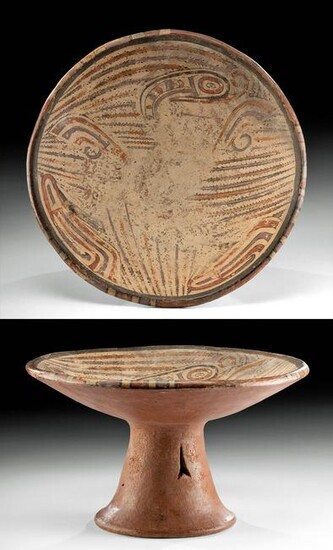Panamanian Cocle Polychrome Pedestal Dish w/ Saurians
Pre-Columbian, Central America, Panama, Gran Cocle culture, ca. 800 to 1000 CE. A hand-built pottery plate of an elegant presentation with a conical foot presenting arrowlike openwork motifs, a wide bowl decorated in tondo with a wondrous stylized mythical, perhaps saurian, creature with barbed elements and finely delineated in red, beige, black, and purple hues - all framed by a red and black border, while the foot and the underside of the bowl is embellished with rich solid red slip. Size: 10.5" in diameter x 6.1" H (26.7 cm x 15.5 cm)
According to scholar Samuel Kirkland Lothrop, "The Gran Cocle culture is a Pre-Columbian archaeological culture that gets its name from the area from which it was based, the now present-day Cocle province of Panama. The Gran Cocle term applies to a loosely studied group of Native American sub-cultures in this region, identified by their pottery styles. The overall period spans a time from 150 B.C. to the end in the 16th century A.D. upon Spanish contact. The most ancient culture is the La Mula period from 150 B.C. to 300 A.D. The La Mula and later Monagrillo and Tonosí pottery styles are identified by their the use of three paint colors which were black, red and white (or cream). The later Cubitá style saw the emergence of the use of four colors. The styles of Conte, Macaracas and Joaquín added purple to their palette and this hue ranged from grayish tones to red purple. The use of purple disappeared in the subsequent styles of Parita and El Altillo and the paint style reverted back to the use of three colors. Most notable in the artistic renderings are the overt use of geometric designs." (For more information, see Armand Labbe, "Guardians of The Life Stream: Shamans, Art and Power in Prehispanic Central Panama" - Bowers Museum of Cultural Art, University of Washington Press, 1995)
Provenance: private Hawaii, USA collection; ex Splendors of the World collection; H. J. Westermann Coll., Germany 1950'-1960's
All items legal to buy/sell under U.S. Statute covering cultural patrimony Code 2600, CHAPTER 14, and are guaranteed to be as described or your money back.
A Certificate of Authenticity will accompany all winning bids.
We ship worldwide to most countries and handle all shipping in-house for your convenience.
#156175
Condition Report: Expertly repaired and restored from multiple pieces, with very limited overpaint along repair lines. Pigment is abraded in areas, mainly on interior of bowl as shown, but still presents nice details. Wonderful deposits on surface as well.
View it on
Sale price
Estimate
Time, Location
Auction House
Pre-Columbian, Central America, Panama, Gran Cocle culture, ca. 800 to 1000 CE. A hand-built pottery plate of an elegant presentation with a conical foot presenting arrowlike openwork motifs, a wide bowl decorated in tondo with a wondrous stylized mythical, perhaps saurian, creature with barbed elements and finely delineated in red, beige, black, and purple hues - all framed by a red and black border, while the foot and the underside of the bowl is embellished with rich solid red slip. Size: 10.5" in diameter x 6.1" H (26.7 cm x 15.5 cm)
According to scholar Samuel Kirkland Lothrop, "The Gran Cocle culture is a Pre-Columbian archaeological culture that gets its name from the area from which it was based, the now present-day Cocle province of Panama. The Gran Cocle term applies to a loosely studied group of Native American sub-cultures in this region, identified by their pottery styles. The overall period spans a time from 150 B.C. to the end in the 16th century A.D. upon Spanish contact. The most ancient culture is the La Mula period from 150 B.C. to 300 A.D. The La Mula and later Monagrillo and Tonosí pottery styles are identified by their the use of three paint colors which were black, red and white (or cream). The later Cubitá style saw the emergence of the use of four colors. The styles of Conte, Macaracas and Joaquín added purple to their palette and this hue ranged from grayish tones to red purple. The use of purple disappeared in the subsequent styles of Parita and El Altillo and the paint style reverted back to the use of three colors. Most notable in the artistic renderings are the overt use of geometric designs." (For more information, see Armand Labbe, "Guardians of The Life Stream: Shamans, Art and Power in Prehispanic Central Panama" - Bowers Museum of Cultural Art, University of Washington Press, 1995)
Provenance: private Hawaii, USA collection; ex Splendors of the World collection; H. J. Westermann Coll., Germany 1950'-1960's
All items legal to buy/sell under U.S. Statute covering cultural patrimony Code 2600, CHAPTER 14, and are guaranteed to be as described or your money back.
A Certificate of Authenticity will accompany all winning bids.
We ship worldwide to most countries and handle all shipping in-house for your convenience.
#156175
Condition Report: Expertly repaired and restored from multiple pieces, with very limited overpaint along repair lines. Pigment is abraded in areas, mainly on interior of bowl as shown, but still presents nice details. Wonderful deposits on surface as well.



